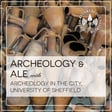
The Roman Fort of Navio with Colin Merrony - Ep 30
Archaeology and Ale is a monthly series of talks presented by Archaeology in the City, part of the University of Sheffield Archaeology Department’s outreach programme. In this talk, Archaeology in the City proudly presents - Colin Merrony on "The Roman For of Navio" This talk took place on Thursday, February 27th, 2020 at the Red Deer in Sheffield.
This month we welcome the University of Sheffield's own Colin Merrony for a chat about the Roman fort of Navio. Colin is a veteran archaeologist and a teaching fellow at the uni, he has done extensive work throughout the Peak District including at Navio. In this talk, Colin explains the history of the Roman presence in the Peak District including their purported lead mining. He takes us through the past and current (and future!) plans to excavate Navio.
For more information about Archaeology in the City’s events and opportunities to get involved, please email archaeologyinthecity@sheffield.ac.uk or visit our website at archinthecity.wordpress.com. You can also find us on Twitter (@archinthecity), Instagram (@archaeointhecity), or Facebook (@archinthecity) Content Warning: Listener discretion is advised as there may be adult language
Affiliates